INDUSTRY INSIGHTS
Direct Mail Trends and Predictions for 2022
We’ve taken a deep dive into some statistics on the mail we catalogue every day. They give us a look at some of the trends that have been driving direct mail over the past few years. We also were honored to receive valuable insights from our panel of experts, which we included in this article.
Direct mail trends have become difficult to anticipate, thanks to the impact of technology and other factors. In 2021, even with the continued pandemic, we saw a sharp economic recovery. Supply chain and labor difficulties present their own challenges to marketers as businesses and consumers adjust to changes in the marketplace, some of which may now be permanent.
WMW! Stats + Views from Experts = Insight
At Who’s Mailing What!, we track a lot of data about the mail we catalogue in our collection each month. A few of these measures are included in this article to describe some of the things going on.
In addition — just like last year — we reached out to industry leaders for their perspectives on the changes happening in direct mail. We thank each of them for sharing their expertise with you, our audience.
By the way, please note that some of these expert discussion points come from Meet the Mailers, our video interview series. Please check them out!
1. Postage Increase
Even though postage is increasing, you want to be smart about it….that is a lever that you can actually turn on direct mail. On display ads — you can’t. I don’t know how many times I’ve purchased something and I got a couple of display ads on my screen at a time for the next month…like that are costing you money.
So even though direct mail has some postage increases, even though there are some paper issues right now in the world, even though all of those things are happening — at the end of the day, direct mail is a hundred percent viewable. So look at the cost on a large scale, direct mail is a very cost-effective way to get a message seen and sent to the right person at the right time.
 Angie ArnspigerVP, Business Development
Angie ArnspigerVP, Business Development
NaviStone
Postage may be increasing, but so are the analytics capabilities available to printers. Print is evolving. A major part of the evolution is how analytics gives the forward-thinking printer a competitive advantage.
Any customer can mail a smaller percentage of the volume they did in 2021 and save on postage. But to get better results with less mail, customers must optimize using data and analytics. This is the perfect opportunity for printers to take the initiative and get a strategic seat at the table. If printers don’t bring the right solutions to be more targeted, their customers will find a partner that will.
Why not be more than ink on paper?
 Phil CorbettDirector Business Development
Phil CorbettDirector Business Development
Analytic Marketing Partners
Let’s get this out of the way — although postage costs go up, they always go up. With the best data hygiene, smart segmentation, and postal automation (among other practices), you can reduce their impact. And it’s important to remember that direct mail enjoys a higher response rate, better message recall, and other advantages over other channels as noted above.
2. Large Postcards
Our clients were so excited about that additional size, it was like “Okay, postage increase…That’s fine. But look at this size!”
We get more real estate in the mailbox. They’re more apt to add a QR code. There’s just a little bit more space to really get the message and the creative out.
So we’ve got a lot of thrilled customers.
 Angie ArnspigerVP, Business Development
Angie ArnspigerVP, Business Development
NaviStone
What’s all this about? One of the actual benefits of the recent USPS postage hike is a change to regulations about postcards that are eligible for discounts. Postcards that measure up to 9” long by 6” high can now qualify for First Class Postcard rates. Large postcards give you more room for your headlines, copy, images, and response CTAs, for a few cents more than mailing at Marketing Mail rates.
As the chart below shows, postcards are becoming an increasingly popular choice for marketers; check out the sharp increase after 2016. Postage rates are only part of the story. Think about how postcards are better for a concise copy (see the next trend), cheaper, and faster to read.
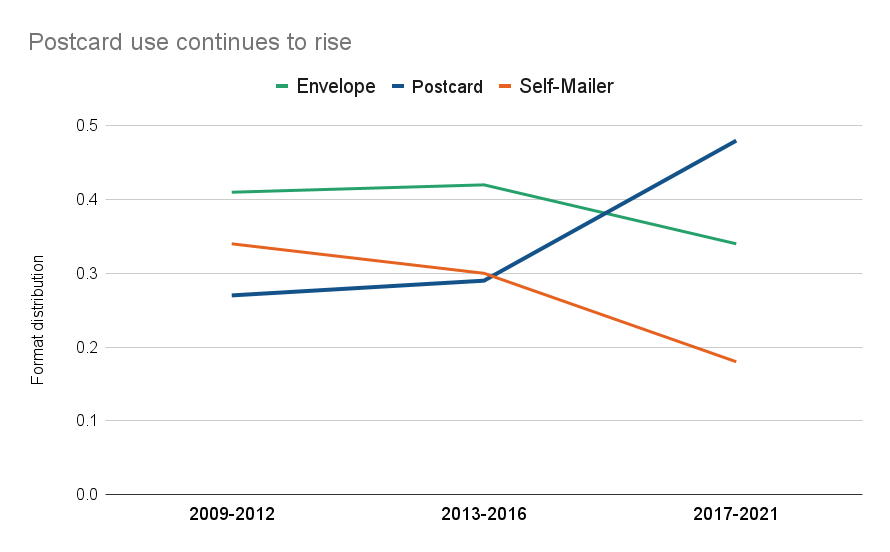
3. Copy is More Concise
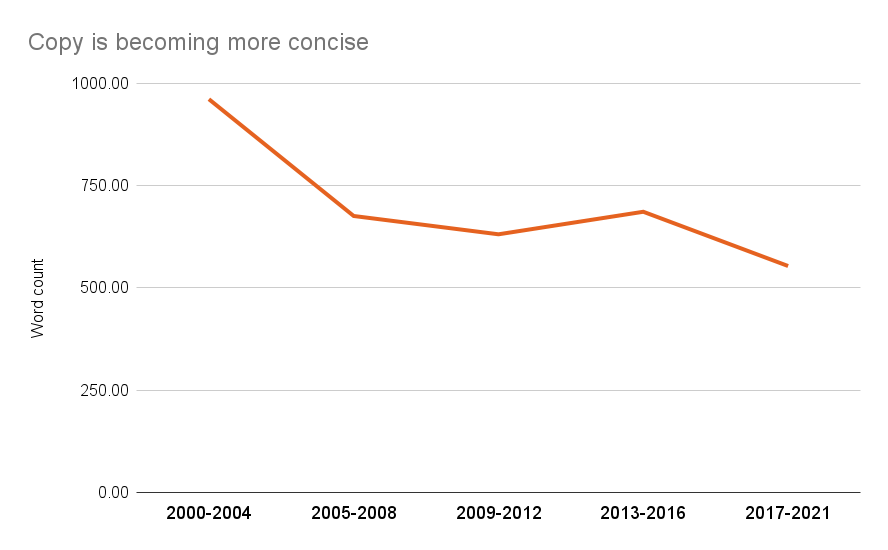
According to statistics from the Who’s Mailing What! database, the word count in direct mail we’ve tracked has declined by 62%. Yes — you read that correctly. Below is a good example from USPS’s holiday-themed folded self-mailers between 2005 and 2021.
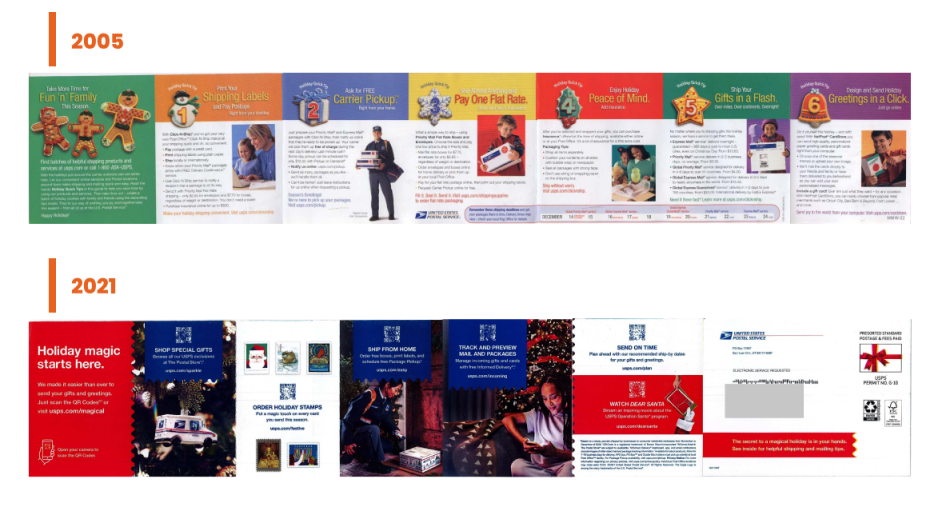
Why is this happening?
Some of the trend can be credited to shorter attention spans. People read less and rely more on images. Higher postage and paper costs also require focusing on essential copy.
Engagement trends show today’s consumers are looking for brevity in marketing interactions. With our own clients, we’ve found that direct mail packages with shorter, more concise messaging are now beating out previous, copy-heavy long-standing controls. As a best practice in both self-mailer and letter package design, we lead with scannability — balancing imagery with short copy blocks that feature key information — often in bullet form. This draws the reader’s eye directly to key information while the negative space surrounding gives eyes the opportunity to rest and focus on what’s important.
Another popular creative strategy is to utilize icons and infographic-style content to provide a more engaging visual story to grab and hold attention. Incorporating QR codes is also a great way for brands to direct audiences to more information or point of purchase, without adding additional copy to the mailer.
 Tari JohnsonCreative Director
Tari JohnsonCreative Director
SeQuel Response
4. Tactile, Sensory and Interactive Mail Piece Engagement
What I find encouraging in folded self-mailers right now is the increased use of simple, production-efficient folds and coupon formats, combined with Informed Delivery campaigns and coordinated email blasts. The “connected mail” scenario is really starting to take hold — certainly through the impressive software technologies that exist today, and through noticeable growth in the awareness and/or willingness to use them.
From a design standpoint, the old-school technique of cramming tons of imagery and messaging into one mailer is giving way to more focused and dynamic promotions with large imagery, airy layouts, strong calls to action, and value-added print techniques for added “pop” and engagement.
I think we’ll see a lot more of the large postcard/billboard mail in 2022 with the addition of the 6” x 9” First Class Postcard size offered by USPS. That’s a really exciting change that we’re not hearing enough about, in my opinion.
 Trish WitkowskiChief Folding Fanatic
Trish WitkowskiChief Folding Fanatic
Foldfactory
Following the strong fourth quarter of 2021, we anticipate a big year for direct mail. However, this year will come with unique and difficult challenges. With major supply chain disruptions that are expected to continue through 2022, it is more important than ever for direct mailers to forecast programs as far out as possible. There is a great opportunity but the ones who plan best will come out as the winners.
We are seeing a very big increase in orders for projects that include tactile and engaging embellishments, much like you see in the packaging industry. These embellishments have been proven to gain exceptional response rates. Now that the USPS is offering a 4% discount on postage through their Tactile, Sensory, & Interactive promotion, we see it being a major factor for organizations to bring value to their branding and direct mail programs.
While there are many challenges in the market, next year looks to be a very exciting time for our industry as direct mail remains such a powerful marketing tool when used in the right way!
 Clint SeckmanPresident
Clint SeckmanPresident
Parkland Direct
Neuromarketing research by Temple University and others shows that physical advertisements influence consumers more than digital ones. Because they are tactile, they leave longer and deeper impressions in the brain, producing both stronger recall and desire for a product or service. With interactive direct mail, you can engage customers in several ways and get them to act.
5. Interactive Technologies are Gaining Popularity
Not to be overlooked, however, is the importance of leveraging technology to deliver fully personalized 1:1, 4-color content. Incorporating data-driven content that is personally relevant, combined with the option of driving multi-channel engagement through the use of QR codes and/or PURLs, consistently provides improved response rates across all self-mailer and envelope enclosed direct mail formats.
With the evolution of digital print, which now includes high-speed, multi-color digital web presses, these personalized programs are quick to market and cost-effective across volumes ranging from 1 to millions. Spire continues to see an increase in clients looking to leverage our turnkey solution for these programs and we expect this trend to grow in 2022.
 Skip DyerExecutive Vice President
Skip DyerExecutive Vice President
Spire
A lot of the clients that we have brought onto the [Voice Activated Call to Action] platform are FinTech and financial clients. I see more growth in retail and in QSR (quick-serve restaurant). I think this is where it can really come alive. But I will say that the success that we’ve seen in FinTech and financial has been really great. It’s just, again, one more way for the consumer to connect.
So far, so good, really loving where this technology is going.
 Mike GundersonFounder & President
Mike GundersonFounder & President
Gunderson Direct
Who’s Mailing What! Insights
Interacting with customers and prospects is no longer a one-way street. To engage with your audience, you have many choices available, such as:
- Social media
- Websites
- Apps
Our Who’s Mailing What! research shows that mail that prompts people to respond with digital channels has soared from under 1% in 2000 to above 10% for the past few years.
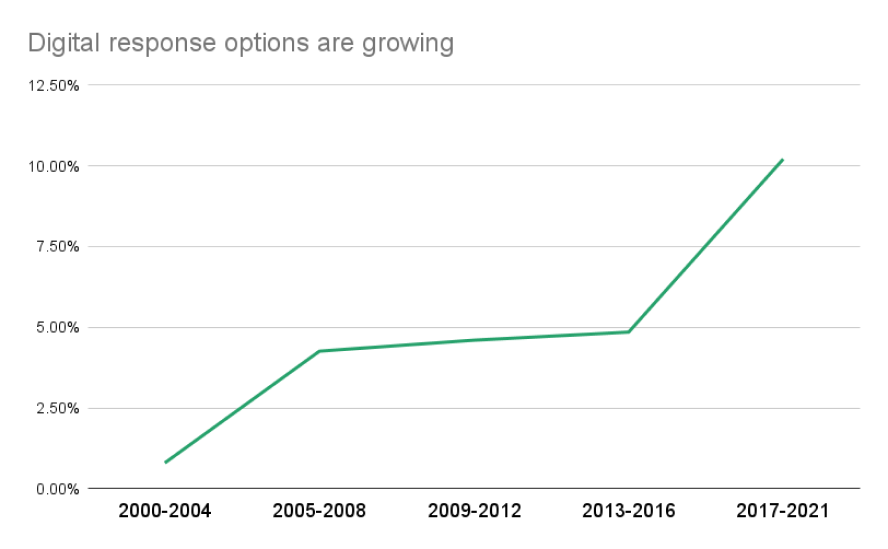
Our analysis of digital response options in 2021 mail reveals that QR code usage now stands at 40%, with websites second at 31.3%.
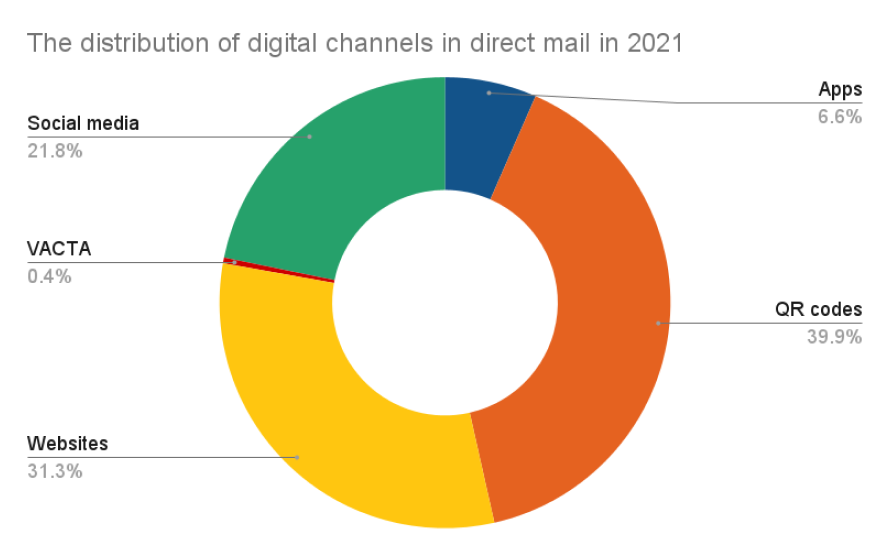
When we analyzed mail by usage of apps, websites, VACTA, QR codes, and social media in their direct mail, we determined which industries ranked the highest for each.
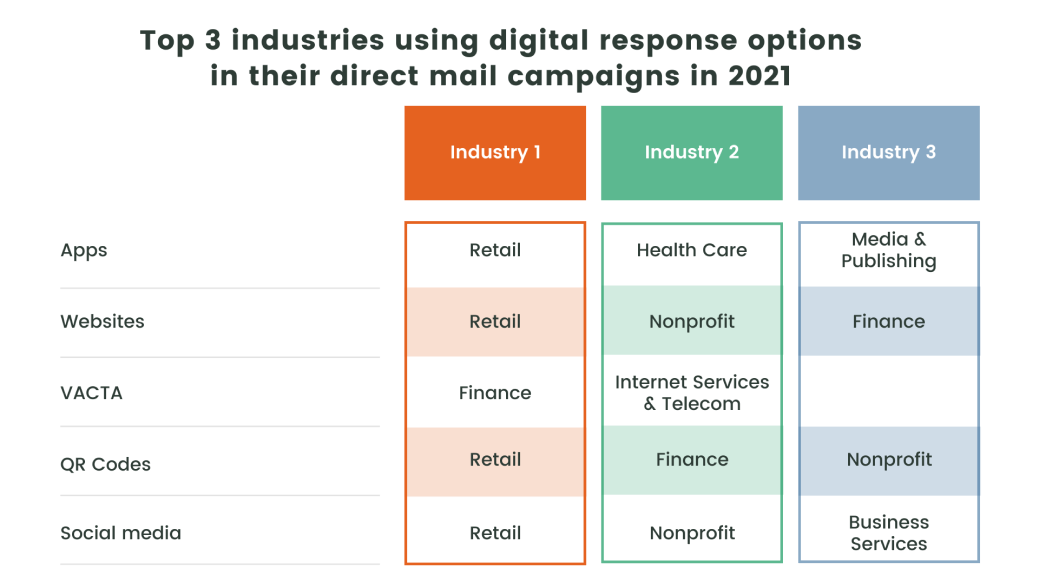
In our research, we looked for and counted specific phrases on mail pieces that indicate a CTA for a specific technology or channel.
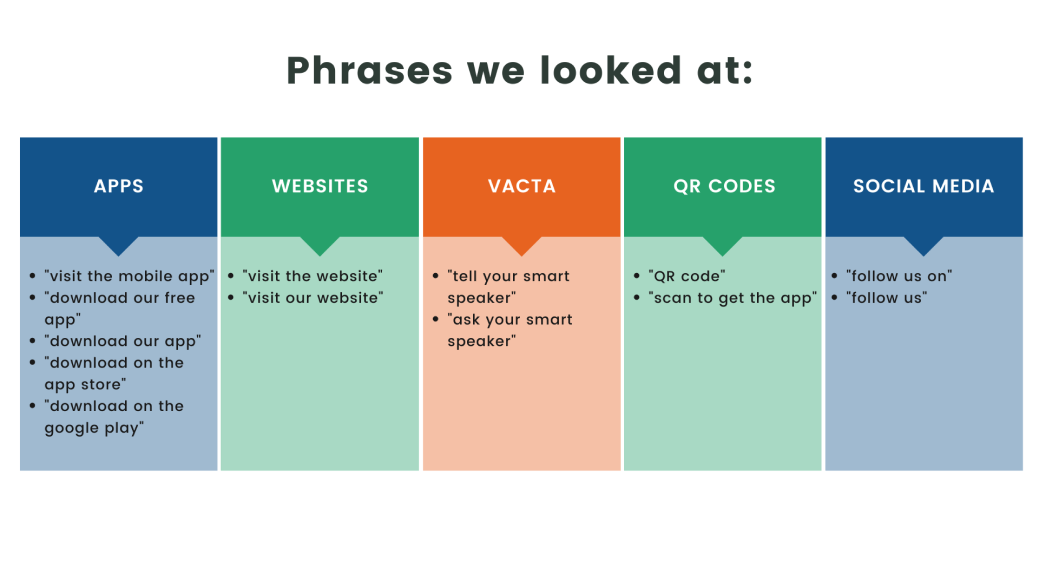
6. Informed Delivery
We believe the use of Informed Delivery campaigns by direct mail marketers is poised to grow dramatically in 2022. Factors driving this growth include the significant rise in household subscriber penetration rates and consistently strong consumer adoption.
Recent statistics from USPS show that consumer interest in Informed Delivery remains strong with average email open rates consistently outpacing the industry average at above 64. Subscriber volume continues to grow significantly as well with over 43MM users currently (a 38% growth rate in the past year).
These campaigns provide marketers an opportunity to enhance physical mail with integrated digital marketing that generates additional consumer impressions, engagement, and results. Perhaps best of all…leveraging this powerful platform with interactive Informed Delivery campaigns is FREE.
 Tracy BrooksFounder & Senior Vice President
Tracy BrooksFounder & Senior Vice President
Salem One
Two big, main reasons we love Informed Delivery for our clients:
One is that they have a clickable digital message as a ride-along to their direct mail. That’s pretty fantastic. And because the audience has grown so much, this is a good thing for direct mailers;
Two – if you add Informed Delivery, if you add the big image and the small image at the bottom, or even just a small image at the bottom, you automatically get sorted to the top of the pile of that Informed Delivery digest. So here you have an opportunity to not only promote your brand and get people to respond before they even receive direct mail – now, we all want to be at the top of the pile. So this is a benefit for marketers to get to the top of the pile, get the first impression.
 Mike GundersonFounder & President
Mike GundersonFounder & President
Gunderson Direct
I’ve been a fan of Informed Delivery since it was introduced in 2017. The 2 colleagues above provide some pretty good reasons why. But I’ll add that in 2022, qualified ID campaigns will get a 4% promotion discount from USPS, up from 2% in the past few years.
7. Personalization
When you combine that full-color variable data print capabilities, along with dynamic content management solutions, you are able to offer very personalized pieces. You have that personalized offer and it’s combined with attractive full-color graphics, you’re really drawing the attention of the recipient.
Some examples that I can think of: when an auto dealer includes an image of a new model of the recipient’s color of vehicle, or like retailers, like Macy’s, for example, including a full-color map of the closest brick and mortar location for the customer. It’s a great opportunity to really make the customer feel like you’re sending this to them.
 Michelle FuchsAccount Manager
Michelle FuchsAccount Manager
IWCO
2021 was a tough year for the direct mail industry. As businesses start to refocus their sights on customer acquisition and retention, direct mail is the best form of media to reach previous customers and attract new ones.
From the ashes of 2021 arises a more cost-conscious buyer of direct mail. The mass mailings of yesterday, “the spray and pray” methodology have been traded for smaller, more targeted, personalized campaigns.
There are multiple ways to personalize content; take color, for example, adding color to a variable marketing campaign has a unique psychological impact on the brain, this effect triggers thoughts, feelings, and emotions leading to increased conversions and revenue.
Simply stated, the demand for custom, personalized campaigns with individualized offers will continue to rise in 2022.
 Shannon YannonePresident
Shannon YannonePresident
MBI Print & Digital Solutions
To make a better connection with a prospect or customer, you need to focus on their wants and needs as an individual. This means targeting them based on their audience segment, if not 1-to-1. Variable data printing (VDP) improves the odds in your favor.
8. Sustainability in direct mail
Sustainable marketing will become a prevalent theme in 2022 as more companies examine their carbon footprints. More marketers will become educated about the environmental impact of direct mail compared to other marketing forms. Few people realize that the electricity used to power digital and video marketing creates more greenhouse gases than the direct mail industry as a whole. Responsible marketers have several tools at their disposal:
-
- Smarter targeting to reduce mail, email, display ad quantity
- Using recycled paper stock — which has improved substantially in the past few years
- Using smaller mail pieces — which consume less paper, require less electricity to produce, and weigh less to ship
- Rethinking marketing communication strategies to consider environmental impact and calculate green ROI so to speak
- Measuring the carbon usage of every marketing campaign
- Purchasing carbon credits or funding reforestation projects to zero out the impact
 Bruce McMeekinCEO & Founder
Bruce McMeekinCEO & Founder
BKM Marketing Associates
At Triadex Services we share concerns about the environment and our impact on it. We offer a variety of environmentally-friendly direct mail marketing solutions. Additionally, Triadex has taken the initiative to plant a minimum of one tree with every order through a partnership with the National Forest Foundation.
This includes orders for:
-
- Plastic Direct Mail Products
- Paper Direct Mail Products
- Digital Campaigns
- List Rentals
We strongly believe it’s important for all industries to reduce their carbon footprint.
 Greg MesarosCEO & Chairman
Greg MesarosCEO & Chairman
Triadex Services
WMW! Analysis of Eco Terms in Direct Mail
We took a deep dive into the environmental messaging found on the direct mail in our collection. As the breakdown below shows, “FSC” (note: for Forest Stewardship Council), “responsible sources”, and “please recycle” were the top 3 eco phrases found on mail in 2021. All are intended to demonstrate sustainable practices by marketers, as well as encourage the same from consumers.
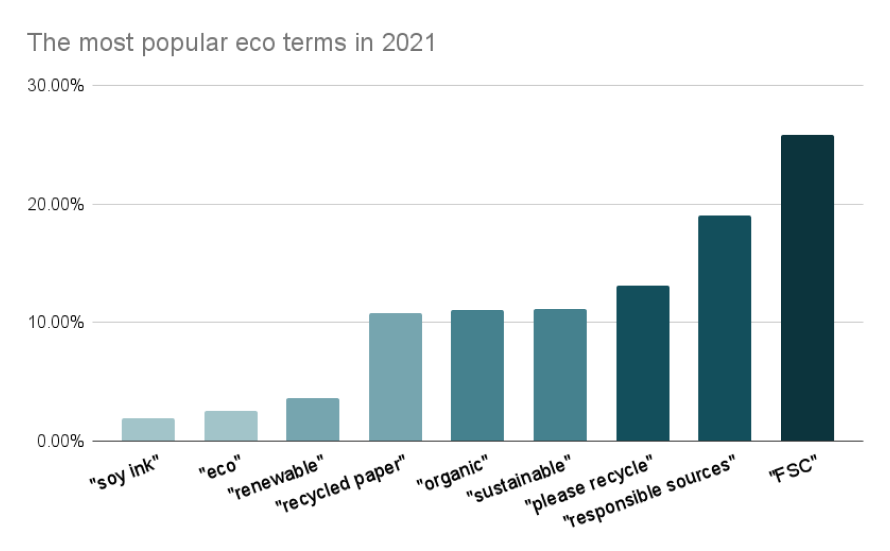
Going green with environmentally-focused messaging has been a growing trend in direct mail as we discussed in an article published on Earth Day in 2021. Fortunately, there are plenty of resources to help you choose the papers, envelope windows, inks, printing processes, and formats that best align with your ecological values — and those of your customers.
Final thoughts
Direct mail volumes, especially Marketing Mail, rebounded to almost pre-pandemic levels in the past year. Companies that reduced or even stopped their direct mail campaigns jumped back in once they saw the effect on their bottom line as economic growth surged.
But in many ways, the digitization of communications continues because there is simply no alternative. To be relevant in 2022 and beyond, marketers have to embrace omnichannel because that is what their customers expect, even if they have clear preferences among the many options available. Today’s printing technologies, personalization, and integration across online and offline channels make it easier than ever to be present for customers wherever and whenever they want.








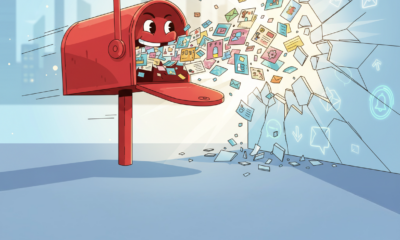
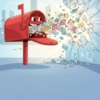


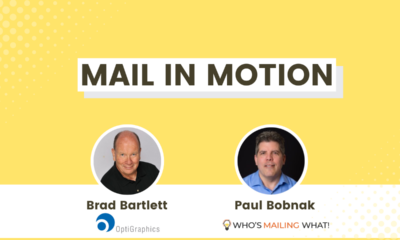














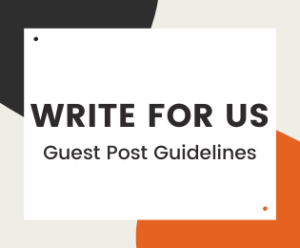



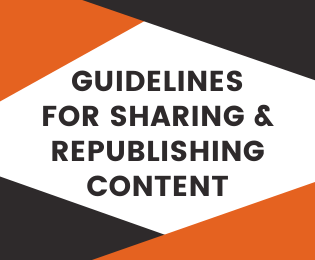

Eric Lambeth
January 18, 2022 at 6:28 pm
“Postcards that measure up to 9” long by 6” high can now qualify for Automated or Presort rates.”
I believe you mean to write: Postcards that measure up to 9″ long by 6″ high can now qualify for First Class Postcard rates.
6×9’s always qualifies for automated + presort rates.
wmwadmin
February 4, 2022 at 2:15 pm
Fixed. Thanks for helping!